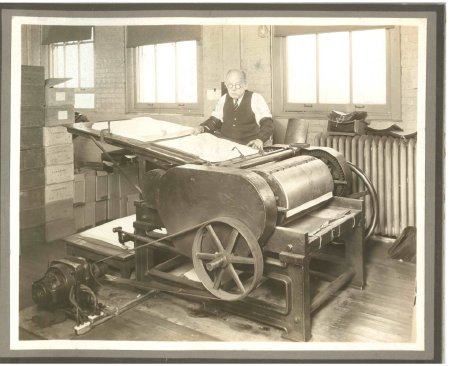Object ID:
2011.52.8
Title:
Huntoon/Spencer Double Cylinder Press
Photographer:
unknown
Date:
ca. 1931
Description:
Black-and-white glossy photo mounted to gray matboard with a black border; balding man in dark vest with striped tie stands behind the Huntoon/Spencer Double Cylinder Press on the third floor of the1923 western annex of the American Printing house for the Blind in Louisville, KY; the man wears dark sleeve-covers over a white shirt and round eyeglasses; his hands grasp a large sheet of paper as he prepares to feed it into the press; a stack of paper rests on a slanted feed table; an electric motor in the left foreground is connected to a spoked drive wheel on the front of the press; a flywheel is seen in the right background; a series of three wooden three-paned double-hung sash windows are in the background with bright light shining through, shades are slightly visible at the tops of the windows, the window on the far left is slightly open; a radiator is visible in the right background behind the press, several stacks of metal embossed plates rest on top of the radiator; more plates rest on the floor; a tall stack of wooden boxes is seen to the left; a Chandler & Price platen jobber printing press is barely seen behind the boxes; an electric light bulb and pull chain is barely visible at the top middle edge.
Dimension Details:
Overall, mounted photo is 10.5 x 8.5"
Medium:
Photographic Paper on mat board
Print Size:
9.5 x 7.75"
Provenance:
Photograph was recovered from APH cafe, where it and others were used as decoration for many years.
In 1884, APH added a second embossing press, built in Chicago by John Spencer, and designed by Superintendent Benjamin B. Huntoon (1836-1919). Huntoon described his press as a "double cylinder press, made from special designs, prints four pages at every revolution, and will make thirty or more revolutions a minute." It was the first press of its type in the world used to produce tactile books.
In 1884, APH added a second embossing press, built in Chicago by John Spencer, and designed by Superintendent Benjamin B. Huntoon (1836-1919). Huntoon described his press as a "double cylinder press, made from special designs, prints four pages at every revolution, and will make thirty or more revolutions a minute." It was the first press of its type in the world used to produce tactile books.
